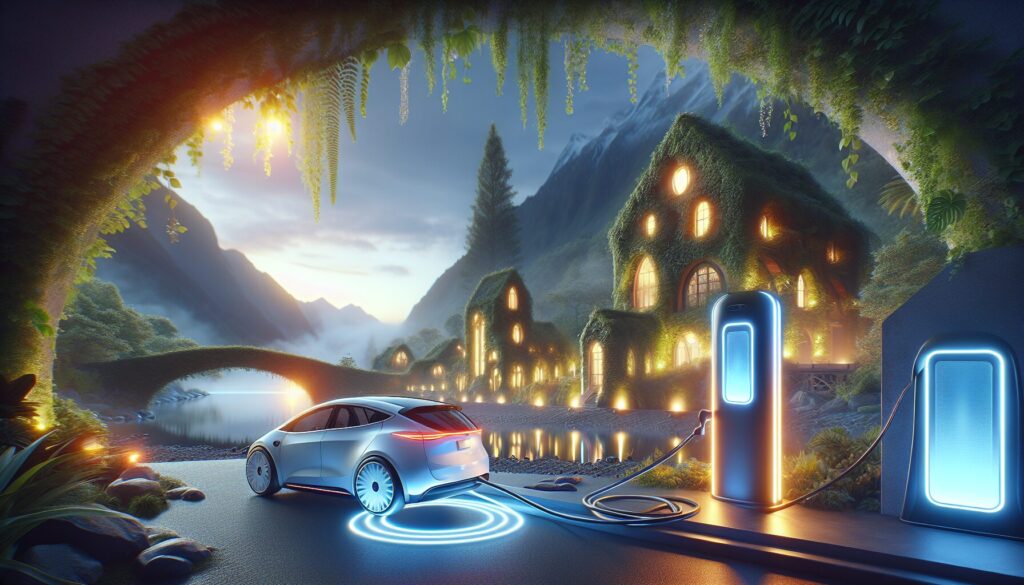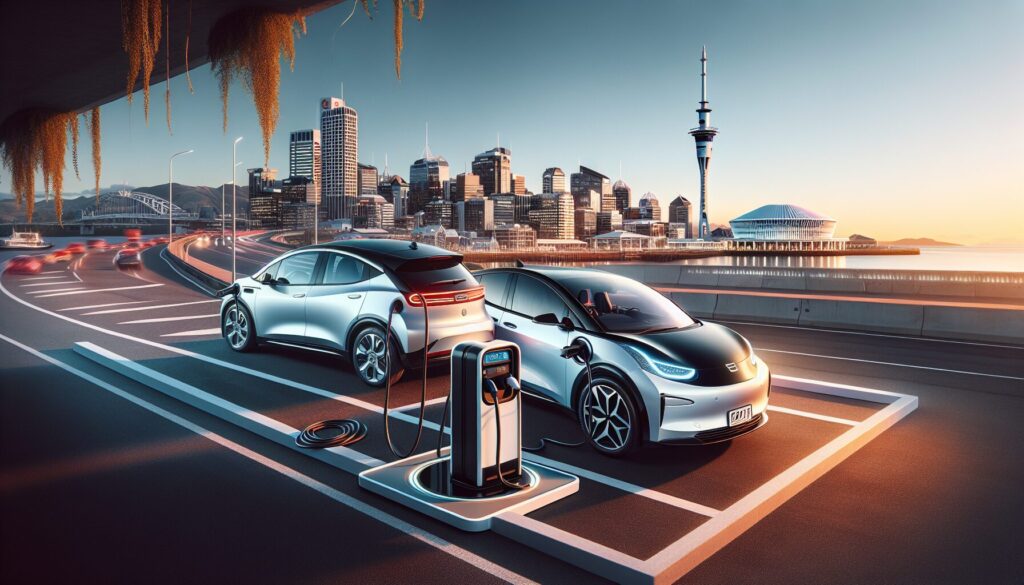Oh, the wonders of technology! Imagine parking your electric vehicle in your garage, and voilà—it’s charging without a single plug or cord. This magic trick is possible thanks to inductive charging systems, which are transforming how we juice up our EVs. I first stumbled upon this fascinating tech during a visit to Qualcomm Halo, where I learned about resonant inductive coupling. It uses magnetic fields to transfer energy between two coils, one in the ground and one in your EV. And let’s not forget the importance of the SAE J2954 standard, which ensures compatibility and safety across different manufacturers. The benefits are numerous: no more fumbling with cords, reduced wear and tear on connectors, and it’s just plain cool! It’s worth keeping an eye on this tech as it continues to evolve, especially here in New Zealand where innovation is always welcome.
Benefits of Inductive Charging Systems
Imagine driving back home after a busy day, and all you need to do is park your electric vehicle. That’s it! No fumbling with plugs or cables, just a seamless start to charging. This is the beauty of inductive charging systems, and it truly makes a difference, especially here in New Zealand where we’re always on the move. These systems leverage resonant inductive coupling, a game-changer for EV owners who appreciate efficiency and convenience.
One of the greatest benefits of these systems is the enhanced safety they bring. Unlike traditional plug-in chargers, there’s no risk of tripping over cords. I remember a friend who used to worry about his kids playing around the charging cables in his garage. With inductive charging, this concern vanished, providing peace of mind. Furthermore, systems designed according to the SAE J2954 standard ensure that safety and performance are top-notch.
Efficiency and Environmental Impact
Moreover, the efficiency of these systems is impressive. Qualcomm Halo technology, for example, optimizes energy transfer, reducing waste and making it a sustainable choice. Walking through Auckland’s bustling streets, it’s clear that reducing our carbon footprint matters to many Kiwis. By adopting such advanced technologies, we’re contributing to a cleaner environment.
- No physical contact required, reducing wear and tear.
- Weatherproof design, perfect for New Zealand’s varied climate.
- Convenient for public and private parking spaces.
Partnerships with global leaders like Qualcomm and standardization initiatives ensure that this technology continues to evolve. It’s a smart investment for the future, aligning with New Zealand’s commitment to sustainability and innovation.
Top Inductive Charging Systems Available in New Zealand

Driving around New Zealand in an electric vehicle is such a joy, especially when you know there are top-notch inductive charging systems available. Let me tell you about a few that really stand out. These systems are designed to make EV life more convenient and are gaining traction here in Aotearoa. It’s like having a personal pit stop, without the hassle of plugging in every time!
One of the popular options is the system from WiTricity. They’re the folks behind some of the most innovative charging technology. Their systems leverage resonant inductive coupling to deliver efficient charging. It’s perfect for those of us who love a seamless experience. Imagine just parking your car and letting the magic happen. No more fiddling with cables in the rain!
Leading the Charge with Innovation
Another standout is the setup from Plugless Power. This company has been a pioneer, pushing boundaries with dynamic wireless power transfer. Their system is designed to comply with the SAE J2954 standard, ensuring safety and efficiency. A friend mentioned how easy it was to integrate this into their daily routine. It’s a hassle-free way to keep your car ready to roll.
Furthermore, Qualcomm Halo technology is making waves with its promise of high-power wireless charging. They’re focusing on making long road trips effortless by reducing charging downtime. I once read an article on BBC discussing the future of EV charging, and Qualcomm Halo’s innovations were highlighted as game-changers.
These systems aren’t just about convenience; they’re about embracing the future of transportation in a sustainable way. With these options, New Zealand is truly on the path to a greener tomorrow.
Installation and Maintenance of Inductive Charging Systems
Thinking about installing an inductive charging system for your EV in New Zealand? You’re in for a treat! When I first helped a friend install one, I was amazed at how seamlessly it integrated into his daily routine. However, let’s dive into the nitty-gritty of installation and maintenance, so you’ll know what to expect.
First things first, the installation process requires a bit of planning. You’ll want to make sure your garage or driveway is ready. This means checking if your power supply can handle the load. Many systems are plug-and-play, but some might need a professional touch. Seeking advice from an expert can ensure you’re meeting the SAE J2954 standard for safety and efficiency. Consider reaching out to companies like WiTricity for specialized guidance.
Maintenance Tips
Once installed, maintaining your inductive charging system is relatively low-key. Here’s a quick checklist to keep things running smoothly:
- Regularly inspect the system for debris or obstructions.
- Ensure the alignment of your vehicle with the charging pad is accurate.
- Update the system’s software for optimal performance.
- Keep an eye on any unusual noises or signals.
If you’re curious about more detailed steps, you might want to check out our article on 7 Essential Tips for Installing Inductive Chargers. It offers some neat tricks to make your setup even more efficient!
Don’t be afraid to experiment with placement, especially if you’re setting up dynamic wireless charging. Remember, every system might have its quirks. A little patience goes a long way in ensuring everything works harmoniously. Happy charging!
Comparing Inductive vs. Traditional Charging Methods

When I first heard about inductive charging systems for EVs, I was intrigued by their potential. Imagine driving home from a long day at work, parking in your garage, and your car just starts charging—no cables, no fuss. It’s like magic, right? But how does it stack up against traditional plug-in methods? Well, let’s dive into that!
Traditional charging involves plugging your EV into a power source, which is straightforward and reliable. However, it requires physical interaction, and let’s be honest, on a rainy Kiwi day, it’s not the most appealing task. Enter inductive charging, which uses resonant inductive coupling to transfer energy through the air. It’s a game-changer in terms of convenience!
Benefits of Inductive Charging
- Convenience: Simply park your car, and it starts charging. No need to handle cables.
- Safety: No exposed wires mean fewer risks, especially in damp conditions.
- Efficiency: With standards like the SAE J2954, efficiency rates are improving continually.
- Dynamic Charging: Some systems allow charging while driving, which is a futuristic perk!
However, traditional chargers aren’t without their perks. They’re generally more affordable and widely available, which makes them practical, especially when you’re on a road trip across New Zealand. The infrastructure is already in place, and even though inductive systems are catching up, they’ll need time to become as ubiquitous. Companies like WiTricity and Plugless Power are leading the charge in advancing this tech.
On a personal note, I chat with fellow EV enthusiasts often, and opinions are mixed. Some love the simplicity of just plugging in, while others rave about the seamless experience of inductive systems. Each has its place, depending on what matters most to you—whether it’s convenience, cost, or tech innovation.
Future Trends in EV Charging Technology
As I was exploring the beautiful landscapes of New Zealand in my trusty EV, a thought struck me—how would future trends in charging technology transform our road trips? Imagine cruising through the lush countryside with dynamic wireless charging, a reality that’s closer than we think. The potential of technologies like Qualcomm Halo and the evolving SAE J2954 standard is pretty thrilling. We’ve already seen how resonant inductive coupling has reshaped charging stations, and it’s only the beginning.
One of the most exciting trends is the push for dynamic wireless charging. Picture your EV getting juiced up while on the move! This could revolutionize long drives across the North Island. With New Zealand’s focus on sustainable energy, integrating such tech could drastically reduce our carbon footprint. Plus, the convenience factor is enormous—no more hunting for charging spots.
Key Players and Innovations
Several companies are leading this charge, if you’ll pardon the pun. Innovations from WiTricity and Plugless Power are paving the way for more efficient inductive charging systems. Their work on aligning vehicles with charging pads automatically reflects a future where human error is minimized.
Additionally, the role of government regulations can’t be overlooked. New Zealand’s policies supporting EV infrastructure development are crucial. They encourage manufacturers to adopt cutting-edge technologies. This synergy between innovation and policy is key for a sustainable future.
However, as promising as these technologies sound, they do raise questions. For instance, how will existing infrastructure adapt? The cost implications for consumers and manufacturers alike are significant. Yet, the benefits, such as reduced charging times and increased convenience, make it worthwhile to navigate these challenges.
As the landscape of EV charging technology continues to evolve, one thing’s for sure—our road trips across New Zealand will never be the same again. Each journey will be smoother, more efficient, and environmentally friendly, enriching our connection with this incredible land.
Conclusion
In essence, the future of electric vehicle charging is bright and promising, with inductive charging systems leading the way toward a more convenient and sustainable automotive landscape. As these technologies continue to evolve, they offer an exciting glimpse into a world where charging is not just a necessity but an integrated part of our everyday lives. Whether you’re a tech enthusiast or simply looking for ease and efficiency, the advancements in EV charging are sure to enhance your driving experience while contributing positively to the environment. Happy charging!
Continue Exploring
Ready to unlock the future of technology? Discover cutting-edge techniques for optimizing inductive charging and stay ahead in 2025. Dive into the insights that will power your devices more efficiently than ever.
Frequently Asked Questions
What are the benefits of using inductive charging systems for electric vehicles in New Zealand?
Inductive charging systems offer several benefits for electric vehicle owners in New Zealand, including the convenience of wireless charging, reduced wear and tear on charging connectors, and enhanced safety by eliminating the risk of electric shock. These systems can easily integrate into various locations, such as home garages and public parking spots, providing flexibility and ease of use.
How efficient are inductive charging systems compared to traditional plug-in chargers for EVs?
Inductive charging systems have made significant advancements in efficiency, achieving rates comparable to traditional plug-in chargers. While early versions had lower efficiency, modern systems can reach efficiency levels of around 90-95%. This makes them a viable alternative, especially as the technology continues to evolve and improve.
Are there any specific inductive charging system brands recommended for electric vehicles in New Zealand?
Several reputable brands offer inductive charging systems suitable for electric vehicles in New Zealand. Some of the leading brands include WiTricity, Plugless, and Momentum Dynamics. These companies provide reliable and efficient wireless charging solutions, catering to a variety of EV models and needs. It’s important for consumers to consider compatibility, charging speed, and installation requirements when selecting a system.


Leave a Reply